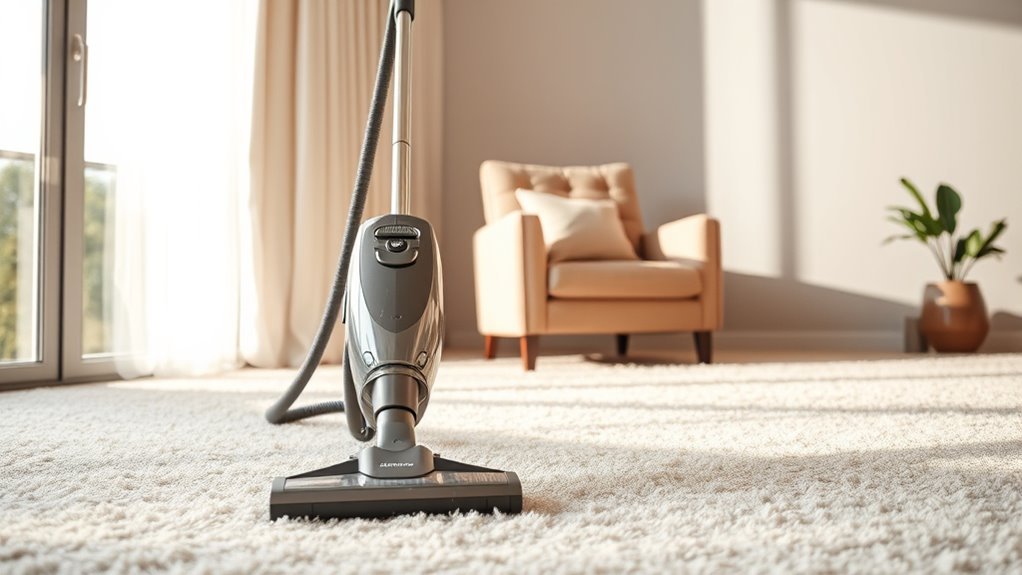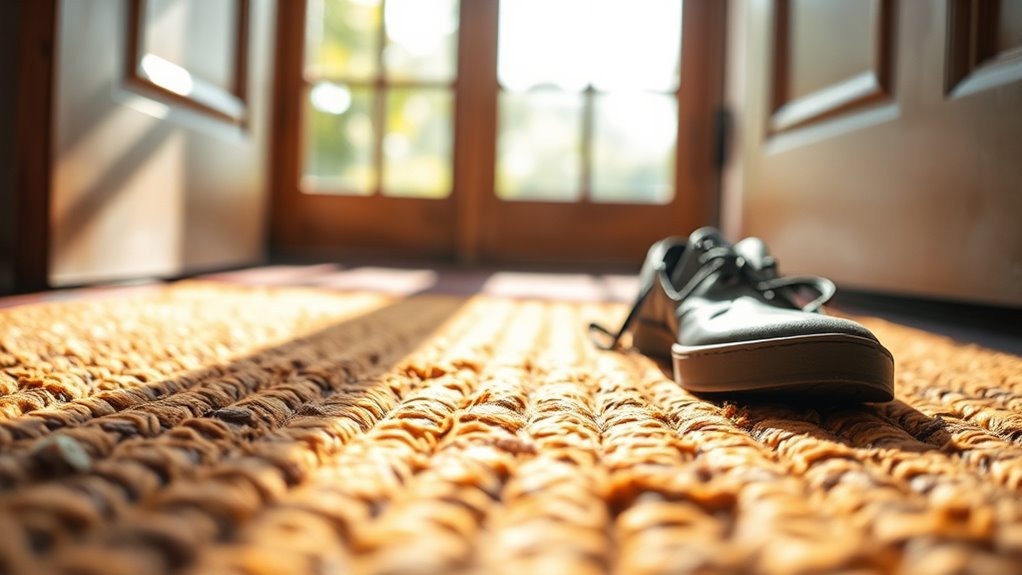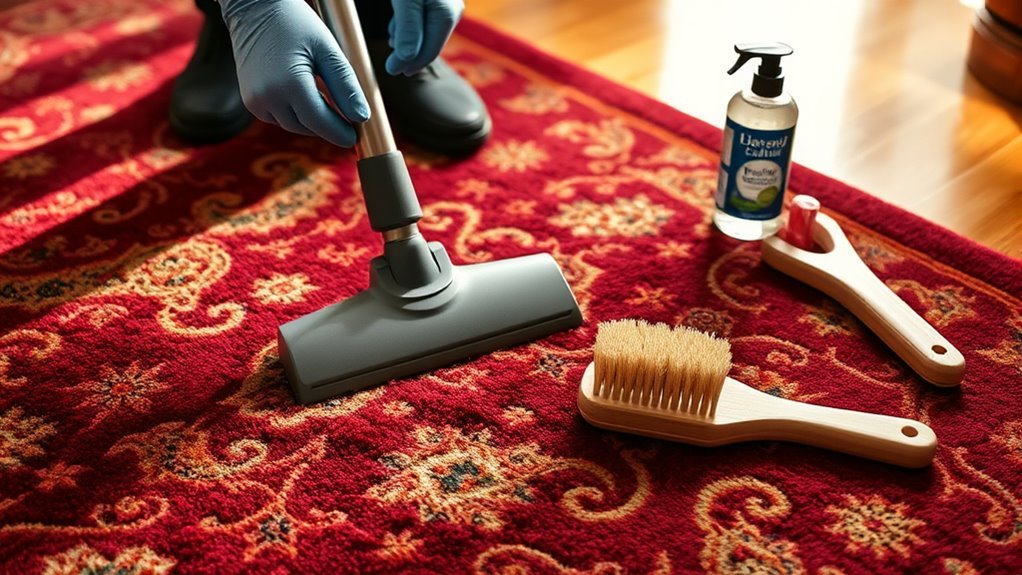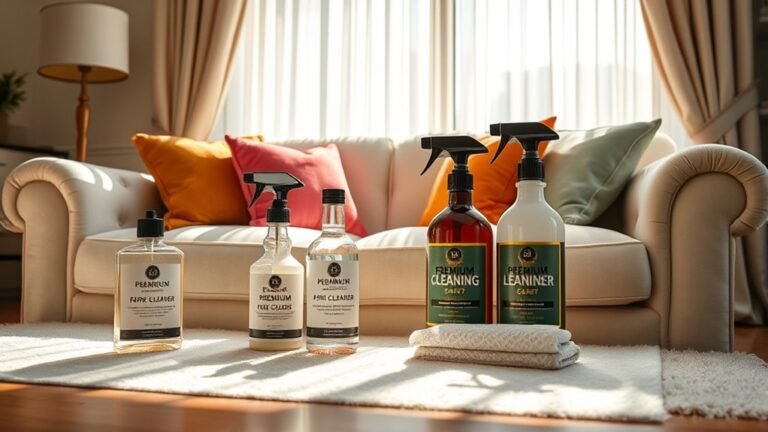Daily Maintenance Tips for Carpet
You should vacuum your carpet regularly with slow, overlapping strokes and adjust the vacuum height to match the pile. Address spills immediately by blotting gently, avoiding rubbing to prevent spreading stains. Use quality door mats placed inside and outside entrances to reduce dirt. Rotate furniture often to prevent indentations and wear patterns, and consider a no-shoes policy. Maintain proper indoor humidity and trim any loose fibers promptly. Following these tips helps protect your carpet’s appearance and longevity—and there’s more to discover for thorough upkeep.
Vacuum Regularly to Remove Dirt and Dust

Regularly vacuuming your carpet is essential to prevent the buildup of dirt and dust that can degrade its fibers over time. You’ll want to adopt effective vacuum techniques, such as slow, overlapping strokes to guarantee thorough debris removal without damaging the fibers. Adjust your vacuum’s height to match the carpet pile for peak suction. As for vacuum frequency, high-traffic areas require vacuuming at least three times a week, while less-used spaces can be maintained with once-a-week sessions. Don’t forget to empty the vacuum bag or canister regularly to maintain suction power. By sticking to these precise vacuuming habits, you’ll preserve your carpet’s texture and appearance, granting you the freedom to enjoy a clean, comfortable living space without constant worry about dirt accumulation.
Address Spills Immediately to Prevent Stains
Because spills can quickly seep into carpet fibers and cause permanent stains, addressing them immediately is essential. When a spill happens, grab a clean cloth and blot—don’t rub—to absorb as much liquid as possible. Rubbing spreads the spill and damages fibers, complicating stain removal. For spill prevention, keep a stain remover spray handy and apply it promptly following the product’s instructions. Test any cleaning solution on a hidden area first to avoid discoloration. After treating, rinse lightly with water and blot again to remove residue. Acting fast not only protects your carpet’s appearance but also extends its life, giving you the freedom to enjoy your space without worry. Immediate attention to spills is your best defense for effective stain removal.
Use Door Mats to Reduce Dirt Entry

Taking immediate action on spills is essential, but preventing dirt from entering your home is just as important in maintaining your carpet’s cleanliness. One effective strategy is to use high-quality door mats made from durable materials like coir, rubber, or microfiber, which trap dirt and moisture efficiently. When selecting door mat materials, consider their ability to withstand heavy foot traffic and outdoor elements. Integrate these mats thoughtfully into your entryway design to encourage everyone to wipe their feet before stepping onto your carpet. Position mats both outside and inside the door for maximum dirt control. By combining functional door mat materials with a well-planned entryway design, you’ll greatly reduce the amount of dirt reaching your carpet, preserving its appearance and extending its lifespan.
Rotate Furniture to Avoid Carpet Wear Patterns
Although carpets are designed to withstand daily use, constant pressure from furniture in the same spots can cause uneven wear and visible patterns. To protect your carpet’s appearance and extend its longevity, regularly rotate your furniture arrangement. This simple step redistributes weight, preventing indentations and fiber crushing in high-traffic areas. Every few months, shift sofas, chairs, and tables slightly or reposition rugs to allow the carpet fibers to recover evenly. When moving heavy items, use furniture coasters or pads to minimize pressure. By consciously varying your setup, you not only refresh your living space’s look but also maintain your carpet’s structural integrity. This proactive approach to furniture placement is key to preserving carpet longevity and enjoying a consistently smooth, attractive surface throughout your home.
Implement a No-Shoes Policy Indoors

When you make a no-shoes policy a standard rule indoors, you greatly reduce the amount of dirt, debris, and oils tracked onto your carpet. This simple practice preserves indoor cleanliness and extends your carpet’s lifespan. To implement it effectively, designate a specific area near entryways for shoe storage—use racks or cubbies to keep shoes organized and off the floor. Encourage family and guests to remove footwear upon entering; providing comfortable slippers can make this easier. Regularly clean the shoe storage area to prevent dirt accumulation. By controlling what touches your carpet, you minimize stains and fiber damage, maintaining a fresher environment. Embracing this policy gives you freedom from constant deep cleaning, letting your carpet stay vibrant and your home feel inviting.
Groom Carpet Fibers to Maintain Texture
Regularly grooming your carpet fibers helps maintain their original texture and appearance, preventing matting and flattening caused by foot traffic. To achieve ideal fiber conditioning and texture enhancement, use a carpet rake or stiff brush to lift and separate fibers, restoring their natural loft and softness. This simple step extends your carpet’s life and preserves its aesthetic appeal, letting you enjoy freedom from frequent replacements.
| Tool Type | Purpose | Frequency |
|---|---|---|
| Carpet Rake | Fiber lifting | Weekly |
| Stiff Brush | Texture enhancement | Bi-weekly |
| Vacuum Brush | Fiber conditioning | Daily |
Incorporate these grooming practices into your routine to keep your carpet looking fresh and inviting, without compromising your lifestyle.
Schedule Periodic Deep Cleaning Sessions
Maintaining your carpet’s texture through grooming sets a strong foundation, but to truly preserve its cleanliness and longevity, you’ll need to schedule periodic deep cleaning sessions. Deep cleaning techniques such as hot water extraction or steam cleaning penetrate fibers to remove embedded dirt and allergens that daily vacuuming misses. Depending on your household’s activity level, your scheduling frequency should range from every six months to once a year. High-traffic areas or homes with pets require more frequent sessions. Mark these appointments on your calendar to guarantee consistency. By committing to this routine, you’ll extend your carpet’s life and maintain a healthier living environment without sacrificing your freedom to enjoy your space fully. Deep cleaning isn’t just maintenance; it’s an essential step in your carpet’s care regimen.
Use Carpet Protectors in High-Traffic Areas
To protect your carpet in high-traffic areas, using carpet protectors is vital as they reduce wear and prevent stains. You’ll want to select protector types based on the traffic level and carpet material, such as mats, runners, or specialized coatings. Choosing the right protector guarantees durability while maintaining your carpet’s appearance and safety.
Benefits of Carpet Protectors
Although high-traffic areas naturally endure more wear and tear, using carpet protectors can considerably extend your carpet’s lifespan. By applying protectors, you boost carpet longevity and enhance stain resistance, ensuring your flooring stays pristine longer. These benefits let you enjoy freedom from constant worry about damage or discoloration.
Here’s what carpet protectors do for you:
- Shield fibers from dirt and debris, reducing abrasion and pile crushing
- Create a barrier against spills, making stains easier to clean
- Maintain the carpet’s original appearance, cutting down on replacement frequency
Incorporating carpet protectors in busy zones is a strategic move. It safeguards your investment and keeps your space looking fresh with minimal effort, allowing you to focus on what matters most.
Choosing Suitable Protector Types
Choosing the right carpet protector involves understanding the specific needs of your high-traffic areas and the types of protectors available. You’ll want to assess foot traffic intensity and potential spill risks to select the best carpet protector types. Popular protector material options include plastic films, fabric mats, and rubber-backed runners. Plastic films offer temporary protection during renovations but can be slippery. Fabric mats provide breathable, durable coverage ideal for daily use, while rubber-backed options prevent slipping and stay securely in place. Prioritize materials that balance protection with ease of cleaning and maintain carpet breathability to avoid moisture buildup. By selecting the appropriate protector material options tailored to your space, you’ll extend your carpet’s lifespan without sacrificing the freedom to walk comfortably and maintain your floor’s aesthetic appeal.
Maintain Proper Humidity Levels to Prevent Damage
When humidity levels aren’t properly controlled, your carpet can suffer from mold growth, fiber distortion, and even color fading. To maintain proper humidity levels and protect your carpet, focus on effective humidity control and moisture balance. Here’s what you should do:
- Use a dehumidifier or humidifier to keep indoor humidity between 30-50%, preventing excess moisture buildup.
- Guarantee proper ventilation in rooms with carpets, especially in basements or bathrooms, to avoid damp conditions.
- Monitor humidity regularly with a hygrometer to catch fluctuations early and adjust your moisture control methods.
Trim Snags and Loose Fibers Promptly
If you notice snags or loose fibers in your carpet, it’s vital to address them immediately to prevent further damage. Start by using sharp scissors to carefully trim the snagged fibers close to the carpet surface, avoiding pulling or tugging, which can worsen the issue. This proactive fiber care step helps maintain the carpet’s appearance and structural integrity. Regularly inspecting your carpet for snags allows you to practice effective snag prevention, reducing the risk of unraveling or matting. By promptly trimming loose fibers, you preserve the carpet’s durability and extend its lifespan. Incorporate this simple yet important task into your daily maintenance routine to enjoy the freedom of a well-kept, snag-free carpet that continues to look its best for years.
Frequently Asked Questions
What Type of Vacuum Cleaner Is Best for Different Carpet Fibers?
When choosing a vacuum cleaner for different carpet fibers, you’ll want to contemplate upright vacuums for thick, plush carpets because they offer strong suction and brush rolls that lift dirt effectively. For delicate or low-pile carpets, canister vacuums are your best bet since they’re gentler and more maneuverable. You’ll appreciate how these options let you maintain your carpets thoroughly without damaging fibers, giving you freedom to keep your home fresh and clean effortlessly.
How Often Should Carpet Protectors Be Replaced?
Don’t let your carpet protector wear out on you—replacement frequency depends on protector materials and foot traffic. For vinyl or rubber protectors, check every 1-2 years as they can crack or lose grip. Felt protectors might need replacing more often due to compression. Keep an eye out for signs of wear or reduced effectiveness to maintain freedom from damage. Regularly swapping out protectors keeps your carpet looking fresh and extends its life.
Can Certain Foods Cause Permanent Carpet Discoloration?
Yes, certain foods like red wine, coffee, and berries can cause permanent carpet discoloration if not treated quickly. To prevent food stains and discoloration, you’ll want to blot spills immediately with a clean cloth, avoiding rubbing. Using a carpet protector can also help create a barrier against stubborn stains. Consistent, prompt action is key to discoloration prevention, letting you enjoy your carpet’s vibrant look without worry.
Are Natural Cleaning Products Safe for All Carpet Types?
Imagine a gentle morning breeze lifting sunlight onto your carpet’s fibers. Natural cleaners can be quite effective, but you’ve got to take into account carpet fiber compatibility. While many natural cleaning products are safe, some delicate fibers like silk or wool may react differently. Always test a small area first to guarantee no damage or discoloration occurs. This way, you maintain your carpet’s beauty while enjoying the freedom of using eco-friendly solutions confidently.
How Do Pets Affect Carpet Maintenance Routines?
Pets definitely change how you approach carpet care. You’ll find pet hair accumulates quickly, so regular vacuuming with a specialized pet hair attachment is essential. For stain removal, act fast—use pet-safe cleaners to tackle accidents before they set. Maintaining this routine keeps your carpet fresh and extends its life, giving you the freedom to enjoy your pets without worrying about lasting damage or odors.






